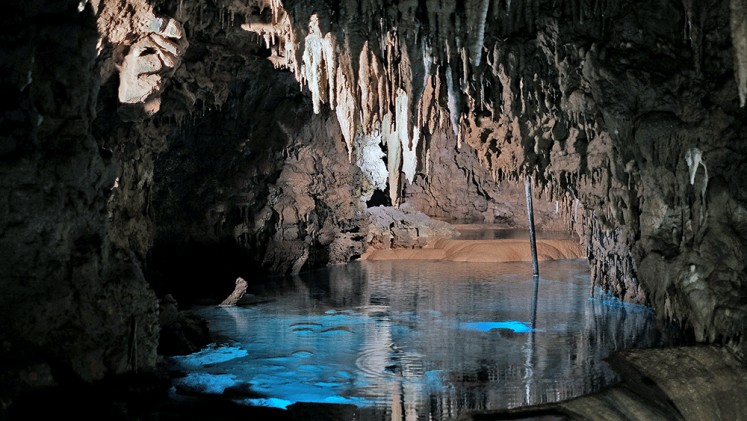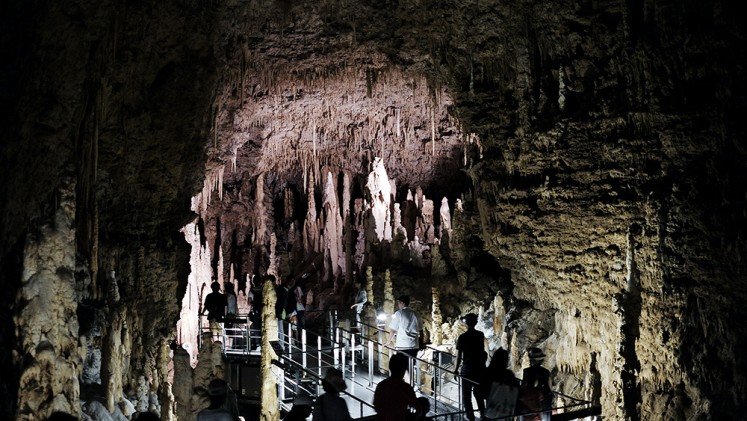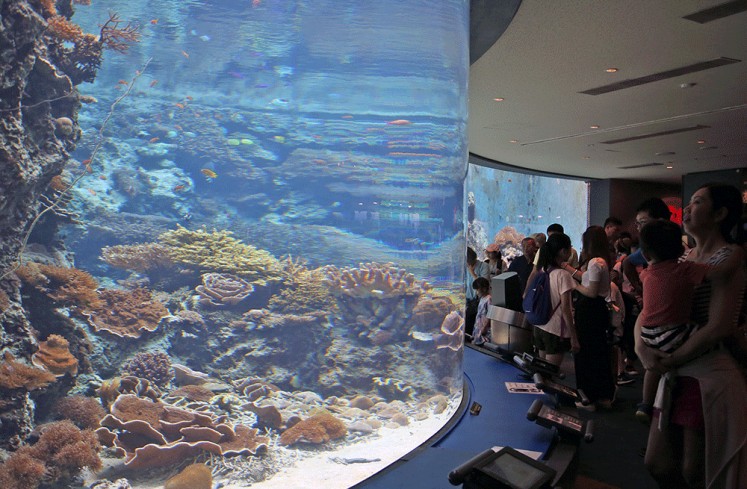Okinawa: More than just the birthplace of karate
Okinawa offers so much more than just being a birthplace of the globally popular form of martial arts.
Change Size
 Deep blue sea: A whale shark passes in front of visitors who enjoy a clear view into the Kuroshio Sea aquarium, the largest installation at the Okinawa Churaumi Aquarium. (The Jakarta Post/P.J. Leo )
Deep blue sea: A whale shark passes in front of visitors who enjoy a clear view into the Kuroshio Sea aquarium, the largest installation at the Okinawa Churaumi Aquarium. (The Jakarta Post/P.J. Leo )
O
kinawa in Japan is where karate originated from, but it offers so much more than just being a birthplace of the globally popular form of martial arts.
The island, for example, also offers natural and marine tourist destinations, such as the Gyokusendo Cave and the Okinawa Churaumi Aquarium, for those who want to explore more than its martial arts culture.
The cave is one of the top tourist spots in the Okinawa World zone chosen by Jetstar Asia and the Okinawa Convention and Visitors Bureau, which recently invited The Jakarta Post and three other media outlets to visit the island.
The pathways in the cave are based on a modern concept that is even friendly to disabled people. It features iron-plated paths for trekking, iron fences as route boundaries and an elevator that helps you reach the exit, which is located on a steep peak.
For the residents of Tamagusuku Maekawa in Nanjo town, which is about 14 kilometers from Naha city, the cave has become a major part of their daily lives.
In March 1967, when Okinawa was still under the control of the United States, a survey team from Ehime University studied and explored the cave for the first time. It was later declared safe to be developed into a caving adventure spot and facilities were installed for tourists.
“In 1971, the university’s survey team trekked 1.9 km into the cave and in 1972, it was opened to the public but only along an 800-meter path,” Yuri Kinjo, a bureau staffer, said.

“The team continued to explore Gyokusendo and in 1976 it was announced that the length of the cave was provisionally measured at 5 km, pending new findings,” added Yuri whose father is a US soldier stationed in
Okinawa.
With the rising number of visitors engaged in caving, Gyokusendo’s management, in 1979, opened the Habu Museum Park in the cave zone and in 1996 this tourist zone was renamed Okinawa World. The entrance to the cave was also changed to extend its trek paths from 800 to 890 m.
The cave is the largest and deepest in Okinawa Prefecture and the second deepest in Japan after the Akiyoshido cave in Yamaguchi Prefecture that is 8.9 km deep, with only 1 km being open to caving.
The exotic beauty of the Gyokusendo cave is enhanced by rows of countless stalactites and stalagmites that form an attractive composition, combined with appealing lighting. Unsurprisingly, many people hastily assume that it is a man-made cave.
The Gyokusendo Cave is generously illuminated and the air within it is cool as its circulation is well regulated. The iron-plated paths prevent tourists from becoming soaked by the stagnant water or mud pools as they trek down to the deepest part of the cave.

Okinawa World is also home to the Eisa dance, the island’s energetic folk dance that is accompanied by drums and an Okinawan string musical instrument called sanshin (three strings), along with songs passionately sung to entertain tourists.
It is also worthwhile to visit the Habu Museum Park, where tourists can observe the making of habushu (snake sake).
Meanwhile, at the Okinawa Churaumi Aquarium, visitors can see more than 740 fish species and tens of thousands of other marine life, according to the Okinawa Commemorative National Government Park.
The aquarium was built near the beach so that the species can remain in their natural habitat. In Okinawan, chura is beautiful and umi is the sea.
The Kuroshio Sea aquarium is the length of three Olympic swimming pools.
Behind the 135-ton acrylic glass walls are three whale sharks, manta rays and various other species. The acrylic panels were listed in the Guinness Book of Records as the largest in the world until they were beaten by the Dubai Aquarium in 2008.
The Okinawa Churaumi Aquarium was the first Kuroshio Sea aquarium built for the 1975 World Fair Expo. It was organized to mark the third anniversary of the return of Okinawa to Japan. After the event, the Expo Ocean Park was managed by the central government from 1976 and Kuroshio Sea was reopened on Aug. 8, 1979.

The idea to build a new aquarium sprang up in 1989. Its initial design was ready in 1994 and its details were finished in 1995, followed by construction in 1996.
The old Kuroshio Sea closed on Aug. 31, 2002, and the newly completed building was named the Okinawa Churaumi Aquarium, which opened on Nov. 11, 2002, to mark the 30th anniversary of Okinawa’s return.
The journalists wound up their Okinawa tour by cruising Kokusai Street. It was an enjoyable experience to walk on the street and mingle with local residents at souvenir shops selling various traditional handicrafts, ranging from shisa lions to bin-gata clothes.
The street has several restaurants that offer Okinawa’s delectable cuisine, as well as the Eisa dance. After buying some souvenirs, a few Okinawan words were needed before departing: nifedeberu (thank you) and guburisabira (so long).






